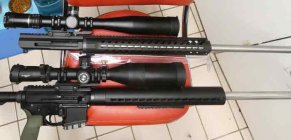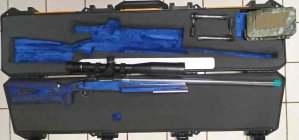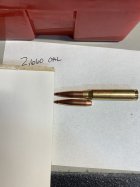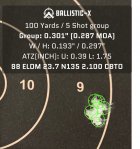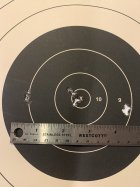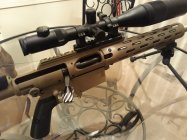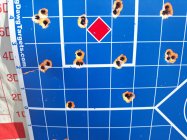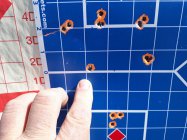For the 88 ELDMs, you are going to want a 1:7-twist barrel, and I would suggest going with a 28" to 30" finish length. You could possibly "get away" with using a shorter barrel, which might also require that other things be done which are really not so great for F-TR...OR you could get the proper length barrel to start with for the intended purpose and not have to run double base powders or high pressures that might kill your brass in a couple/three firings. If you decide to go with a 30" barrel length, I would also strongly suggest getting a .219"/.224" barrel to help mitigate/prevent bullet jacket failures, the probability of which slightly with the longer barrel. These can be obtained from Bartlein or Brux.
The potential problem with using a Savage barrel for this project can be seen merely by taking a look inside one with a borescope. It is not uncommon to see tooling marks in a factory Savage barrel that look like someone drove a tank track up and down the top of the lands. Although Savage rifles often shoot really, really well straight out of the box, their factory barrels are simply not where you want to be for the intended purpose. When pushing a bullet such as the 88 ELDM that is known to be at risk for jacket failures at the kind of velocities often observed with F-TR loads (i.e. typically a bit "warm"), a rough bore in a brand new barrel is really not where you want to be. If your going to go to the trouble of setting up a new F-TR rifle, I'd suggest starting with a quality aftermarket barrel from a reputable barrel manufacturer.
Finally, you might want to talk with your gunsmith about the kind of chamber you're want to get the most out of the 88s. The 88 ELDM is a LONG bullet for a .223 Rem cartridge. Ideally, you want somewhere in the neighborhood of 0.250" freebore to seat the 88s optimally. I just start breaking in a brand new barrel a couple days ago on a rifle specifically set up to shoot 88s and 90 VLDs. My intention is to use this rifle in local F-TR club matches at 600 yd, and I'm not planning to step on the gas with the loads for this rifle, so I went with standard 0.218"/0.224" bore/groove configuration Bartlein 5R barrels at 28" finish length. The chambers were cut with 0.220" freebore, which is just about perfect for the 90 VLD but is a bit on the short side for the 88 ELDM. When seated at "touching" the lands in a chamber with 0.220" freebore, the 88 ELDM boattail/bearing surface junction is very close to the case neck/shoulder junction, which a bit further down into the neck than is optimal, and higher operating pressure will be the likely result. I can hopefully get away with that due to not wanting to push these loads very hard in matches at 600 yd, but it's still sub-optimal. Setting a rifle up to load/shoot the 88s optimally may well mean that you don;t have a lot of options for loading other bullets, as the 88s are so long. Using a 0.220" freebore will mean loading 90 VLDs optimally and 88s a tad short, but will work "acceptably" for both. Using a 0.250" freebore will likely mean the only bullets you can load without jumping a country mile would be the 88 ELDMs, Sierra's 95 SMKs, and possibly the 90 gr A-tips. It's something to think about about and discuss with your gunsmith so you end up with a rifle setup that will do what you want. Loading crazy long and heavy bullets in the .223 Rem sometimes requires that some major compromises be made; i.e. having a "purpose-built" rifle that may not be so useful for anything else.
Based on my initial results with Barrel #1, I should have no difficulty hitting velocities in the 2725 to 2750 fps range with 88s and 90s, brass life should be quite good, and hopefully bullet jacket failures a non-issue with the slower velocity and slightly shorter barrel length (I typically would run these bullets at 2800+ fps from 30" barrels in F-TR matches). Wind deflection with these loads will be slightly greater than when running the same bullets at 2825 to 2850 fps from a 30" barrel, but the difference is not HUGE. Running 90 VLDs at 2750 fps instead of about 2830 fps means about one inch greater wind deflection is predicted at 600 yd. So not zero, but not an overwhelming difference, either. Again, if you have the conversation with whomever is going to do the gunsmithing work, you should be able to come up with a plan that will get you where you want to be with the 88s to give F-TR a try, but that won't leave you with a rifle so specialized that it isn't much use for anything else.
Finally, it's also worth re-iterating that the Unithroater tool only removes the tiniest little bit of metal from the bore, as mentioned by others above. It is SUPER EASY to make a mistake and go well beyond the intended freebore length when using this tool. Once removed, the metal can't be put back so be careful, take very small cuts, and measure often when using the Uni-throater tool.










